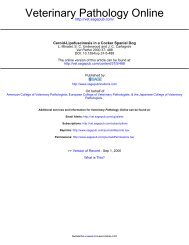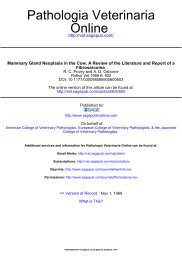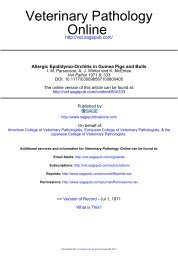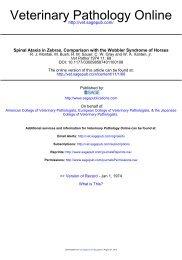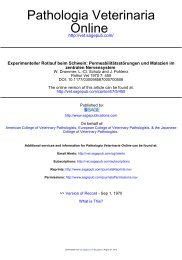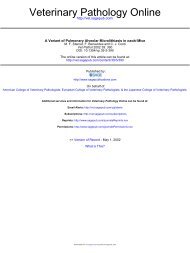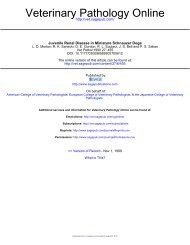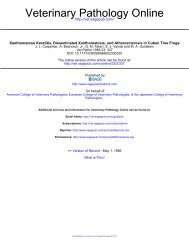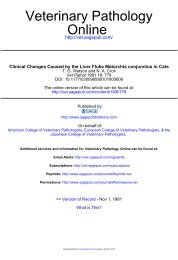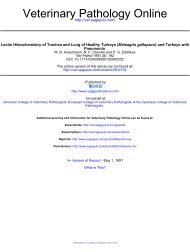Histopathologic Features and Post-surgical Sequelae
Histopathologic Features and Post-surgical Sequelae
Histopathologic Features and Post-surgical Sequelae
You also want an ePaper? Increase the reach of your titles
YUMPU automatically turns print PDFs into web optimized ePapers that Google loves.
Vet Pathol 30:499-504 (1993)<br />
<strong>Histopathologic</strong> <strong>Features</strong> <strong>and</strong> <strong>Post</strong>-<strong>surgical</strong> <strong>Sequelae</strong> of<br />
57 Cutaneous Neoplasms in Ferrets<br />
(Mustela putorius furo L.)<br />
G. A. P A R K ER AND C. A. P ICU T<br />
Biotechnics, Sterling, VA<br />
Abstract, The study o f the signalme nt, histomorphologic features, <strong>and</strong> po st -<strong>surgical</strong> clinical progress of 57<br />
cutaneous neo plasms in 55 domes tic ferrets (Mustela put orius I ura L.) was based on diagnostic path ologic<br />
ac cessions ( 198 7-1 992) fro m 142 ferrets. Mea n age of th e gro up was 4.3 years; 3 1/54 (57 %) were female <strong>and</strong><br />
23/ 54 (43%) were ma le, T hirt y-three (58%) of the cuta neous neoplas ms were bas al cel l tumors. T he mean age<br />
o f ferrets wit h ba sal cell tumor wa s 5.2 yea rs, a nd 23 /33 (70%) were female. Hi stologica lly, th e ba sal ce ll tu m o rs<br />
were co m posed of well-differentiated basaloid epithelia l ce lls with vario us degrees of sq uamous <strong>and</strong> sebaceous<br />
differentiation , sim ila r to those see n in basal ce ll neoplasms ofdogs. Nine ofth e 57 (16%) cuta neous neo plasm s<br />
were mastocytomas. The mean age of ferret s with mastocytoma was 4.1 yea rs; four were male, four were fem ale,<br />
a nd th e sex ofo ne wa s unrecorded . Hi st ologicall y, th e mastocytomas were composed of well-differentiated mast<br />
ce lls with few cosino phils, similar to cuta neous mastocytomas of domestic cats. The mast ce lls had a small<br />
num ber o f metachromatic cyto plas m ic gra nules, <strong>and</strong> in six of eight neoplasm s th e gra nules had an affinity for<br />
co nj uga ted avidin-peroxidase. Six o f th e cutaneous neoplasms (II %) were fibromas. The mean age of ferret s<br />
wi th fi bro m a was 2.7 yea rs; 5 (83(\10) were male. Two cu taneo us heman giomas (4%) were in fem a les, which were<br />
4 <strong>and</strong> 5 years of age. There was o ne each hemangiosarcoma, cutaneo us po lyp, ana l gl<strong>and</strong> ad enocarcinoma,<br />
lym ph osarco ma of th e pre puce <strong>and</strong> inguinal lymph node, <strong>and</strong> adenocarcinoma of the prepuce .<br />
Key words: Bas al ce ll tumor; ferrets; fibroma; fibrosarcoma; mastocytoma; neoplasia; spontaneo us disease.<br />
The ferret (Mustela spp.) is generally recognized as<br />
a low tumor incidence species.'? Th e most commonly<br />
reported tumors are lym ph osarcoma <strong>and</strong> ovarian neoplasms,<br />
although the incidence ofovarian neoplasms<br />
is strongly influenced by the report of 20 ovarian leiomyo<br />
mas in a single colony of ferrets." Cutaneous neoplasms<br />
arc the th ird most commonly reported neoplasms.<br />
A review ofpublished reports an d unp ublished<br />
case reco rds from 16 diagnostic laborat ories revealed<br />
161 neoplasms in ferrets , 30 of which were located in<br />
the skin or subcutis.'? Published reports of cutaneous<br />
<strong>and</strong> subcutaneous neoplasms include four ferrets wit h<br />
squamous cell carcinorna.v'



